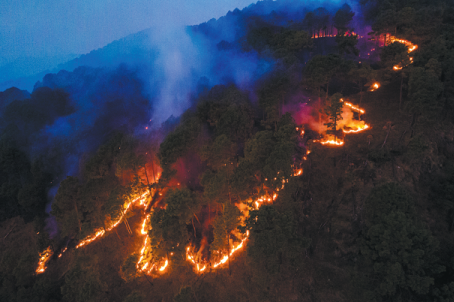Tourism and biodiversity at risk as raging wildfires devastate forests in Nepal


An alarming rise in the number of forest fires has been devastating Nepal's forests and releasing massive amounts of carbon that threaten both biodiversity and the economy, according to a new research which warns that the worst is yet to come.
In February, wildfires ravaged around 82 hectares of forest land in Sindhupalchok, particularly in the upper regions of Jugal and Bhotekoshi rural municipalities. The blazes took days to extinguish. Similarly, a wildfire in Liping forest in ward 2 of Bhotekoshi rural municipality burned down 35 hectares.
In Dolakha, a massive fire scorched hectares of forest land in the Gaurishankar Conservation Area. The fire, which started on Jan 28, was brought under control after nine days. Before that, it had spread over 600 hectares, including critical red panda habitats.
A wildfire in the forests of Timang in the mountain district of Manang started on Feb 1 and burned for days before dying out.
The research indicates that Nepal's forest fires could release over 170 million tons of soil organic carbon and 325 million tons of aboveground wood carbon, amounting to more than 495 million tons of carbon emissions. This underscores the urgent need for fire mitigation and forest management.
While forests can regenerate after fires, full recovery can take nearly a decade.
Over 5,200 fire incidents were reported in Nepal last year, the second highest incident after 2021, when 6,537 such cases were reported, according to the Department of Forest and Soil Conservation.
The wildfire season in Nepal has just begun and is expected to peak in April and May. Experts warn that fire-induced air pollution could overwhelm hospitals with respiratory cases.
Open fires and wildfires emit hazardous pollutants such as particulate matter, nitrogen oxides, carbon monoxide, sulfur dioxide, lead, and mercury. These toxins have both short-term and long-term health consequences.
Kathmandu Valley is particularly vulnerable. The research notes that smoke from forest fires often settles in the bowl-shaped capital, creating a persistent haze over the city.
"It's just the start, as the worst is yet to come," Bhupendra Das, an air quality expert, said in a recent interview. "The prolonged dry spell will likely lead to more wildfires, and authorities are ill-prepared to tackle them."
Poor air quality can cause pneumonia, bronchitis, conjunctivitis, skin allergies, strokes, and heart problems in the short term. Long-term exposure increases the risk of lung and intestinal cancers, kidney disease, and cardiovascular conditions.
Forest fires not only threaten biodiversity but also impact Nepal's food supply, tourism, and local economies.
Tourism, a key pillar of Nepal's economy, depends on protected areas and national parks, which are now at risk. Last year, wildfires severely impacted Pokhara, a popular tourist city, disrupting flights for weeks due to dense smoke.
Hotel operators report that, in recent years, smog from forest fires has lingered over Kaski and Annapurna until the arrival of monsoon rains, obscuring mountain views from tourist hot spots like Ghandruk.
In the spring, Nepal's peak tourist season, wildfires in the Tarai region affect flights. Last spring, Janakpur Airport, a key pilgrimage site, saw nearly a week of flight cancellations due to farm fires.
Call to action
The new research conducted by experts from Arizona State University, Jackson State University, the University of Groningen, and Kathmandu Forestry College, used NASA Earth Observations and machine learning to analyze fire risks over the past two decades.
It is Nepal's first national-scale study on the fire-carbon-biodiversity nexus.
Experts note that Nepali farmers increasingly burn vegetation due to labor shortages. Traditionally, most farmers avoided burning straw and used it to feed livestock, but this practice is changing.
"As happened in the case of the recent Los Angeles wildfires, Nepal is trapped in a carbon-temperature feedback loop," said Kshitij Dahal, a doctoral student at Arizona State University and lead author of a research article titled "Nepal's carbon stock and biodiversity are under threat from climate exacerbated forest fires".
In a brief statement released to the media, he said, "The difference is Nepal's fires threaten biodiversity found nowhere else on Earth."
"If we do not act now, we risk losing critical biodiversity and worsening global climate change," said Professor Ambika P. Gautam of Kathmandu Forestry College. "We urgently need better fire management strategies."
Wildfires have a big impact on Nepal's national parks and wildlife reserves.
According to research, Koshi Tappu Wildlife Reserve and Chitwan, Banke, Bardiya, Shuklaphanta, and Parsa National Parks are highly susceptible to wildfires, threatening rare species such as Bengal tigers, one-horned rhinos, and wild elephants.
Nepal's southern provinces, including Lumbini and Madhesh, face the highest wildfire risks. Six of Nepal's 20 protected areas, including Chitwan and Bardiya National Parks, are under extreme threat.
Rocky Talchabhadel of Jackson State University warned, "Our models show that wildfire risk in Nepal's south has been rising since 2001. Without action, these fires could wipe out decades of conservation progress and transform vital carbon sinks into carbon sources."
The study calls for immediate fire mitigation strategies, including community-led patrols to detect and control fires early, AI-based early warning systems to predict and prevent wildfires, and cross-border collaboration to leverage South Asian climate partnerships.
Prajal Pradhan of the University of Groningen emphasized the need for sustainable solutions: "This isn't just about stopping fires. Nepal must integrate climate action and biodiversity protection into sustainable development initiatives."
For example, sustainable forest management — such as controlled timber harvesting — can reduce fire risks while ensuring long-term forest health.
The Kathmandu Post, Nepal































